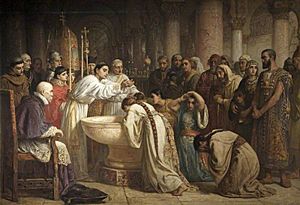Treaty of Granada (1491) facts for kids

|
|
| Context | The Reconquista and the Spanish takeover of the Emirate of Granada |
|---|---|
| Signed | November 25, 1491 |
| Signatories | |
The Treaty of Granada, also called the Capitulation of Granada, was a very important agreement. It was signed on November 25, 1491. The people who signed it were Boabdil, the leader (sultan) of Granada, and Ferdinand and Isabella, the King and Queen of Castile, León, Aragon, and Sicily.
This treaty officially ended the Granada War. This war had started in 1482 and ended with a big fight and siege around the city of Granada in 1491. The treaty created a short break in fighting. Then, in January 1492, the Muslim rule over Granada ended. Granada had been a Muslim kingdom since the 1200s.
The treaty promised many rights to the Moors, who were the Muslim people living there. These rights included being able to practice their religion freely and being treated fairly. This was in exchange for them surrendering. The agreement also gave Jews in the area a choice. They could either become Christians or move to North Africa within three years. However, this part of the treaty was later changed by the Alhambra Decree in 1492. That decree forced all Jews in Spain to either become Christian or leave the country.
What the Treaty Promised
The Treaty of Granada in 1492 had 67 different rules. Here are some of the most important promises made:
- Everyone, rich or poor, would be safe. Their families and belongings would also be protected.
- People could stay in their homes and towns, whether in the city or the countryside.
- Their laws would stay the same. No one would judge them except by those laws.
- Their mosques (Muslim places of worship) and religious buildings would remain as they were.
- No Christian should enter a Muslim's house or be rude to them.
- Muslims who were captured during the siege of Granada would be set free. This was especially true for important leaders.
- Muslims who had escaped from Christian owners and found safety in Granada would not be sent back. However, the Sultan would pay their owners for them.
- Anyone who wanted to move to Africa could leave within a certain time. The king's ships would take them there. They would only pay for the journey, not extra taxes.
- After that time, Muslims could still leave. They would pay for their journey and a small tax on what they took with them.
- No one should be punished for someone else's actions.
- Christians who had become Muslim would not be forced to change back to Christianity.
- If a Muslim wanted to become Christian, they would have a few days to think about it. Then, a Muslim and a Christian judge would talk to them. If they still wanted to change, they could.
- No Muslim would be punished for the death of a Christian during the siege. Also, no one had to return property taken during the war.
- Christian soldiers would not stay in Muslim homes against their will. Muslims would not be forced to move to other parts of the kingdom.
- Taxes would not increase. In fact, unfair taxes that had been added recently would be removed.
- No Christian should look into a Muslim's house or enter a mosque.
- Any Muslim traveling or living among Christians would be safe. Their belongings would also be safe.
- Muslims would not have to wear special badges or marks, like Jews and Mudejars did.
- Muslims would not have to pay taxes for a certain number of years.
- The Pope (the leader of the Catholic Church) was asked to agree to these rules and sign the treaty. (This request was not carried out.)
How the Treaty Broke Down
At first, the Catholic rulers followed the treaty's promises. They even set up a shared city council in Granada. Muslims were allowed to choose their own leaders. Even though some Spanish church leaders wanted to force Muslims to convert, King Ferdinand decided to let them be. He hoped that by being around Catholics, Muslims would choose to change their faith on their own.
Hernando de Talavera, a kind and moderate friar, became the archbishop of Granada. He believed in teaching people about Christianity through calm discussions, not through punishment. When Ferdinand and Isabella visited Granada in 1499, Muslims even welcomed them warmly.
However, another powerful church leader, Cardinal Francisco Jiménez de Cisneros, came to Granada. He did not like Talavera's gentle approach. Cisneros started sending Muslims who did not want to convert to prison. He treated them harshly until they agreed to become Christian. As more people converted, Cisneros pushed even harder. In December 1499, he told Pope Alexander VI that three thousand Muslims had converted in just one day! Even Cisneros's own church council worried that his methods might be breaking the treaty.
In December 1499, all these forced conversions led to trouble. An incident where authorities tried to force a Muslim woman (who had become Christian and then Muslim again) to change back sparked an open revolt. This happened in Albayzín, the Muslim part of Granada. Talavera and Captain-General Tendilla talked with the Muslims and calmed the situation.
Meanwhile, Cisneros was called to the royal court to explain his actions. He convinced the King and Queen to forgive the rebels. But there was a condition: the rebels had to convert to Christianity. Because of this, the entire city of Granada became Christian, at least officially. This was the beginning of the end for the Treaty of Granada.
See also
- List of treaties
- Reconquista
- Morisco Revolt
- Timeline of the Muslim presence in the Iberian Peninsula
- In Spanish: Capitulaciones de Granada para niños


